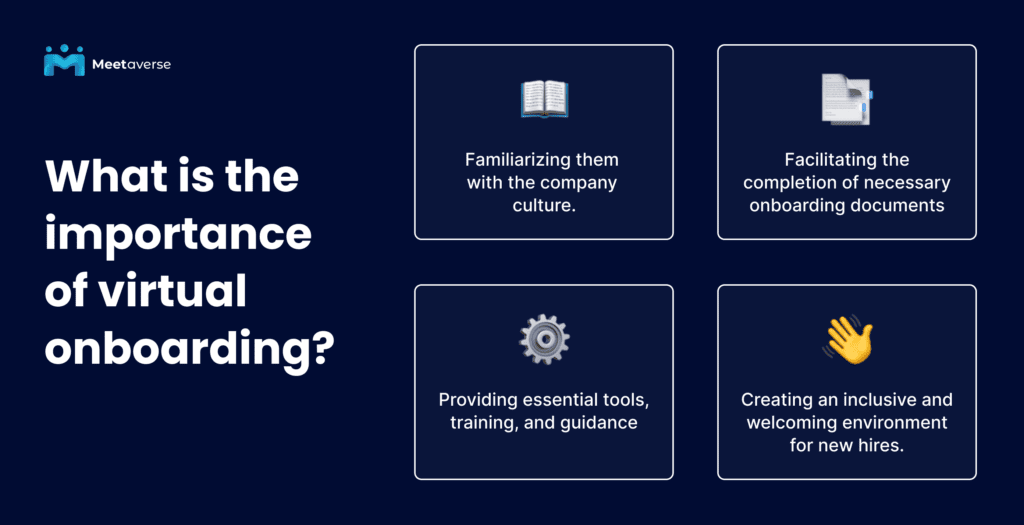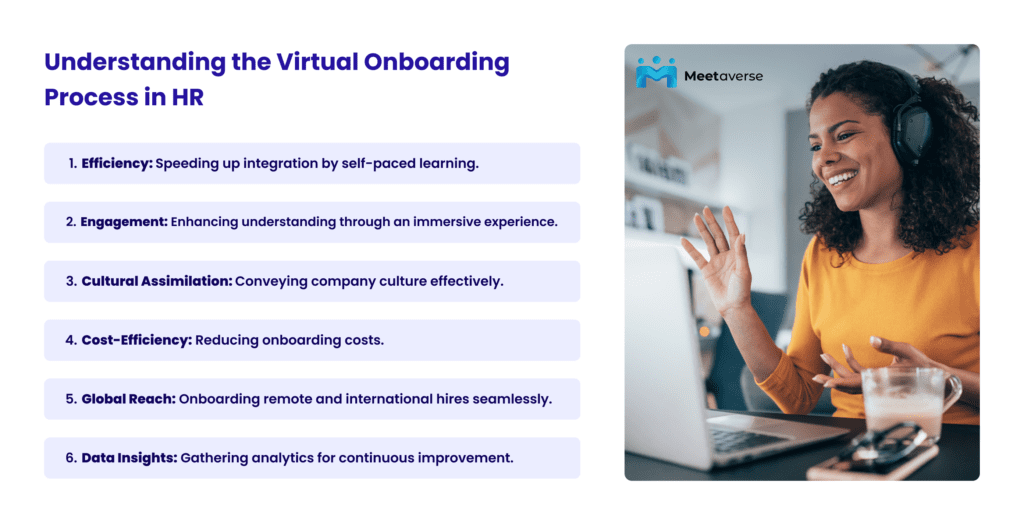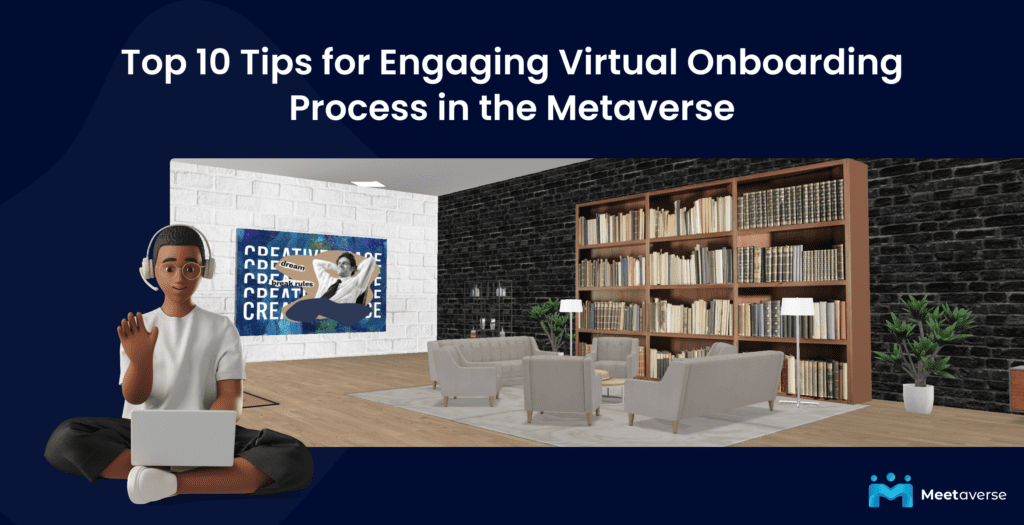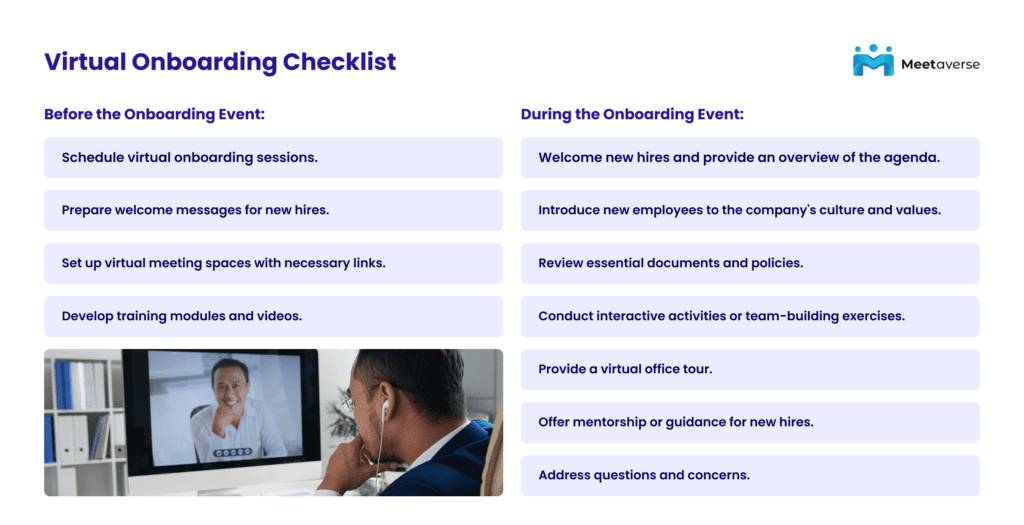
The way we work has changed a lot because of COVID-19, making remote work and online meetings more common.
People are getting used to working from home, and we don’t need to have as many in-person meetings as before. Because of this, companies are changing how they bring in new employees. This is where virtual onboarding comes in. It’s a new way to welcome and train new team members.
But what exactly is “metaverse onboarding”, and how does it differ from traditional onboarding?
Come with us as we check out what virtual onboarding is, why it matters in today’s work world.
Virtual onboarding meaning is a modern way to help new employees adjust to a company, even without in-person meetings. It uses tools like video calls to guide them, making it great for remote workers.
This doesn’t just introduce employees to the company; it also gives them a plan to fit in with the company culture and make sure they’re ready for success.
With simple ideas, you can make virtual onboarding more fun.
Here are a few examples:

These virtual employee onboarding ideas make virtual onboarding fun and engaging.
The difference between virtual onboarding and onboarding lies in how they are conducted. Traditional onboarding typically involves in-person meetings, face-to-face training, and physical paperwork. Virtual onboarding uses video calls and online activities to teach new employees about the company when they can’t meet in person.
One key difference is how we onboard remote workers. In traditional onboarding, employees often have to travel to a physical office for training. But with virtual onboarding, we help them join the team without coming in person, which saves the company money.
Virtual onboarding offers employers a prime opportunity to acclimatize new team members by:

Virtual onboarding and training meaning for employees.
The metaverse can make onboarding virtual employees even more exciting and immersive. The metaverse is a digital world that makes it possible for employees to connect and work in new and fun ways.
But what are the benefits of virtual onboarding within this metaverse environment?
In short, the metaverse adds excitement to onboarding, makes it affordable, and helps new employees get used to a new way of working.

HR professionals are in charge of the virtual onboarding and training process. This process has many steps and focuses on helping new employees smoothly become part of the company using a virtual onboarding roadmap.
This highlights how important virtual onboarding is for employee training and integration.
Let’s explore these elements in more detail:
The remote onboarding process uses technology, interactive learning, and virtual tools to make sure new employees are ready to start their new jobs, making it a valuable approach for onboarding in a virtual environment.
Many companies are now realizing the importance of using virtual onboarding in the metaverse. This change is driven by the numerous benefits it brings to both the new hires and the organization.
Virtual onboarding enhances engagement, streamlines processes, and offers flexibility for a smoother onboarding experience. It’s not just a fad; it’s a strategic move that helps companies better equip new employees and enhance their overall operations.
Looking for effective HR virtual solutions?
Leave your contact information and a Meetaverse professional will be happy to tell you more about how we can help
When it comes to virtual onboarding best practices, there are several key strategies to ensure a successful transition for new employees into the metaverse. This includes understanding how companies do virtual onboarding effectively and the tools they use to create a seamless and engaging virtual new hire onboarding experience.

Effective virtual onboarding begins with careful planning and preparation. Thorough planning ensures that the virtual onboarding process runs smoothly and efficiently. It includes tasks like:
A detailed timeline is crucial to coordinate all these elements, allowing for a seamless experience. Adequate preparation is essential to make a positive first impression on new hires.
One critical element of this preparation is having a comprehensive virtual onboarding checklist in place to ensure that no essential steps are missed in the process. This level of detail helps create a smooth and efficient virtual onboarding experience, setting a positive tone for new hires’ entry into the company and enhancing the overall virtual onboarding and the new hire experience.

Personalization is at the heart of successful virtual onboarding. Acknowledging and catering to the unique qualities and needs of each new hire is crucial. By tailoring the onboarding process to align with their skills and preferences, new employees feel valued from day one.
This personal touch can involve:
Personalization of virtual onboarding programs extends to incorporating enrollment and onboarding virtual trials, which allow new employees to familiarize themselves with their roles through immersive experiences.
Virtual reality (VR) makes onboarding fun. It lets new employees explore a virtual workplace, which is great for employee virtual onboarding process:
By utilizing VR, new hires can explore their digital workspace even before they physically set foot in the office. This immersive technology can be applied to various aspects of onboarding, such as:
The result is a seamless transition into their roles and a more engaging onboarding experience.
For a more enjoyable virtual onboarding experience, include fun activities during the virtual onboarding session. New hires can take part in games, act out scenarios, and solve puzzles. Here are some straightforward ideas for virtual onboarding new employees:

These creative virtual onboarding ideas make virtual onboarding more engaging.
Gamification adds fun and competition to onboarding, boosting engagement. You can introduce quizzes, virtual onboarding challenges, and rewards to keep new hires motivated. Leaderboards display achievements, fostering a sense of accomplishment.
Gamification not only encourages active participation but also fosters a sense of teamwork, especially important when onboarding virtual team members who may be geographically dispersed.
In virtual onboarding, talking and getting help are really important. When new employees can talk easily and get help when they need it, they feel more connected.
Make sure they have regular chats with mentors or managers and clear ways to ask questions or share worries. This kind of support helps them feel like they belong and not alone, which is common in virtual work settings, and it’s especially crucial for virtual assistant onboarding.
Feedback from new hires is invaluable for ongoing improvement in the best virtual onboarding process. Actively seek input and constructive criticism to identify areas that may need enhancement. Make sure to provide new employees with the means to offer feedback anonymously if they prefer.
This iterative approach helps organizations adapt and refine their virtual onboarding procedures, ensuring they stay relevant and effective, ultimately answering the question of how to improve virtual onboarding.
Selecting the right tools and virtual training platform for onboarding is a crucial decision.
To make an informed choice, consider the following factors:
Meetaverse stands out as an excellent choice due to its user-friendly interface and comprehensive features.This includes virtual onboarding programs, interactive content, and multiple communication channels that enhance efficiency and engagement.
Now, let’s examine several valuable tools designed to facilitate the virtual onboarding process:
Meetaverse is our modern virtual onboarding solution, made to improve your onboarding process. By using Meetaverse, you’ll simplify the experience, boost efficiency, and strengthen the connection to your company’s culture. It offers interactive learning, personalization, and gamification for engaging onboarding. Plus, it provides helpful analytics, scalability, and customizable digital spaces and avatars to mimic your office.
To see if virtual onboarding is working well, you need to look at some important numbers. These numbers include how many new hires finish the onboarding, how quickly they start doing their job, and if they’re happy with it.
Key Metrics for Virtual Onboarding:
Our platform, Meetaverse, has tools that give more info than just the basics. It tells you how much new hires are involved, what they’re doing, and how well they’re doing it. Looking at this info helps you make decisions based on data and make the onboarding in the metaverse better.
In virtual onboarding, don’t forget to celebrate when new employees reach milestones. It could be completing training, doing well in team activities, or hitting project goals.
Recognizing their accomplishments is a great way to keep them motivated and involved. It also helps create a positive company culture and shows you value their efforts.
These best virtual onboarding tips make the virtual onboarding experience in the metaverse a success. They make things efficient, engaging, and memorable for new hires.
We urge organizations to adopt these strategies for a brighter future in employee orientation. Embrace the metaverse and these innovative methods to lead the way in excellent onboarding and provide the best virtual onboarding experience.
Join us for a demonstration and step into the future of onboarding today.
Looking for effective HR virtual solutions?
Leave your contact information and a Meetaverse professional will be happy to tell you more about how we can help
Conducting successful virtual onboarding involves a systematic approach to ensure that new employees seamlessly integrate into their roles and the company.
Here are the essential steps to guide you through the process:
Step 1: Preparation: Gather all necessary materials and resources for the onboarding process, including training modules, documents, and equipment.
Step 2: Introduction Meeting: Schedule a virtual orientation meeting with the new employee, welcoming them to the company and providing an overview of the onboarding process.
Step 3: Role and Responsibilities: Clearly communicate the new employee’s job role, responsibilities, and expectations, discussing their specific tasks and goals.
Step 4: Company Culture: Educate the employee about the company’s culture, values, mission, and vision, ensuring they understand the organization’s ethos.
Step 5: Training and Learning: Implement interactive training methods, such as video presentations, online courses, and quizzes, to facilitate skill development and knowledge acquisition.
Step 6: Engagement and Interaction: Promote engagement through team-building activities, virtual meetings, and open communication channels that allow employees to connect with colleagues.
Step 7: Feedback and Assessment: Gather feedback from the new hire to evaluate their onboarding experience, making adjustments as necessary to enhance the process.
Step 8: Performance Monitoring: Continuously monitor the employee’s performance and provide necessary support to ensure they integrate successfully into their new role.
Step 9: Follow-Up: Maintain regular communication with the new employee after the initial onboarding period to address questions, offer guidance, and facilitate a smooth transition into their position.
The difference is how they are done. In regular onboarding, it often happens in person, with face-to-face training and paperwork. Virtual onboarding uses digital tools like video calls, webinars, and online activities to introduce new employees to the company’s culture and what’s expected of them. It’s all about using technology when meeting in person isn’t possible.
The virtual onboarding process in HR means helping new employees, especially those who work remotely, become part of the company in a smooth way. HR uses online tools and activities to make sure new hires quickly understand their roles, the company culture, and feel included. It’s about getting them ready for their jobs, even when they can’t be in the office.
Virtual onboarding should include things like:
Support and Resources: Access to mentors, support personnel, and relevant resources for ongoing development.
These components ensure that new employees receive a comprehensive introduction to the company, their roles, and the culture while engaging in a virtual onboarding process.
Here are the key steps for virtually onboarding an employee:
Step 1: Begin with a warm welcome and company overview, highlighting values and mission.
Step 2: Conduct job-specific training sessions to explain responsibilities and expectations.
Step 3: Provide essential digital resources for skill and knowledge development.
Step 4: Organize online team meetings to facilitate virtual introductions and social interaction.
Step 5: Ensure access to mentors, support personnel, and relevant resources for continued growth within the company.
Companies use various online tools like videos, slides, and chats to teach new hires about the company and their roles. These tools are used to help remote employees get used to the company’s culture and what’s expected of them, even if they can’t meet in person.
The online onboarding process is about helping new employees start their jobs using digital methods. This includes things like filling out forms online, watching training videos, and accessing important materials, all through the internet.
Virtual onboarding plays a crucial role in organizational success. It ensures that new employees are thoroughly prepared for their roles and helps them seamlessly integrate into the company’s culture and work environment. By simplifying and enhancing the onboarding process, organizations save time and resources while fostering a sense of belonging and motivation among employees. This, in turn, results in increased productivity and long-term success for the organization.
A Checklist: Start with a list of important tasks, such as paperwork and team meetings, to help new employees get organized.
Virtual Onboarding Games: Use quizzes and challenges in the virtual onboarding process to teach company rules and engage new hires.
Personal Touch: Add a personal touch by incorporating virtual icebreakers and online meetings to help new employees connect with their colleagues.
Fun Virtual Onboarding Ideas: Enhance the experience by showing videos, sharing stories, or using virtual reality to help new hires gain a better understanding of the company.
Learn from Experience: Allow new hires to practice the onboarding process before their official start date to build confidence and familiarity.
These virtual employee onboarding ideas are designed to make the virtual onboarding process enjoyable and engaging for new team members.
The corporate world has undergone significant changes due to employee virtual tr...
read moreHR enters the metaverse, and it plays a critical role in facilitating the integr...
read more


